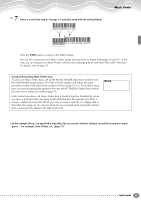Yamaha PSR-2100 Owner's Manual - Page 30
Style s, Use the same operations as in Playing a style on s 28 and 29.
 |
View all Yamaha PSR-2100 manuals
Add to My Manuals
Save this manual to your list of manuals |
Page 30 highlights
Playing Styles Style Sections Each style in the auto accompaniment is made up of "sections." Since each section is a rhythmic variation of the basic style, you can use them to add spice to your performance and mix up the beats - while you're playing. Intros, Endings, Main patterns, and Breaks - they're all here, giving you the dynamic elements you need to create professionalsounding arrangements. INTRO MAIN BREAK ENDING This is used for the beginning of the song. When the intro finishes playing, accompaniment shifts to the main section. This is used for playing the main part of the song. It plays an accompaniment pattern of several measures, and repeats indefinitely until another section's button is pressed. This lets you add dynamic variations and breaks in the rhythm of the accompaniment, to make your performance sound even more professional. This is used for the ending of the song. When the ending is finished, the auto accompaniment stops automatically. 1 - 3 Use the same operations as in "Playing a style" on pages 28 and 29. 4 Press the [INTRO] button. BREAK INTRO MAIN ENDING / rit. 5 As soon as you play a chord with your left hand, the Intro starts. For this example, play a C major chord (as shown below). Split Point Auto Accompaniment section When the playback of the intro is finished, it automatically leads into main section. 6 Press any of the MAIN [A] to [D] buttons or [BREAK] MAIN button as desired. (See the Accompaniment Structure BREAK INTRO on the next page.) or 7 Press the [AUTO FILL IN] button to add a fill-in, if necessary. Fill-in patterns play automatically between each change in the Main sections. AUTO OTS FILL IN LINK 8 Press the [ENDING] button. MAIN BREAK INTRO This switches to the ending section. When the ending is finished, the style automatically stops. ENDING / rit. ENDING / rit. 30 Quick Guide















